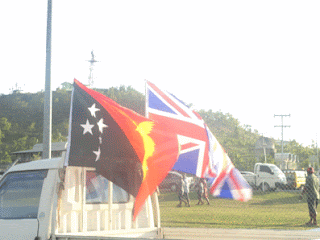Wantoks and friends,
Just in case you missed them, here is a mix of some current news and articles on Manus and PNG that are available on the internet.
Instead of being in the news for the fiesty performance of the famous Manus dancers or being the smallest and most northerly province of PNG, Manus is receiving a lot of attention these days for hosting one of the Temporary Regional Processing Centers (TRPC) for asylum seekers attempting to enter Australia by boat. The first batch of asylum seekers were transported to Manus last week. There are several sources for news on the first transfer last week of asylum seekers to the reopened Manus TRPC. In addition to news items in PNG's dailies the Post Courier and the National, you can also read about the transfer in Autralian news sites such as the ABC http://www.abc.net.au/news/2012-11-21/first-asylum-seekers-arrive-on-manus-island/4383876 . Photos of the first transfer to the Manus TRPC last week can be viewed at http://www.newsroom.immi.gov.au/photos/temporary-regional-processing-centre-in-manus-island-3 .
The Last Laughing Death
This is a story of the last death of the dreaded desease the kuru which was first detected and studied in PNG among the Fore people and the work of pioneer scientists like Dr. Michael Alpers (pictured above) and his group. This interesting and informative story can be read at: http://www.theglobalmail.org/feature/the-last-laughing-death/470/
Now for something really exciting. In my search to find stringband music of the Pacific in Europe, I stumbled upon Fasfowod Stringband of Germany. This is a group of musicians who simply love the earthy but uplifting stringband music of Vanuatu and have taken up playing this kind of music. Interestingly, I found out that Fasfowod has done a cover of one of PNG's own Oshen's songs "Meri Lewa". I would not mind seing Fasfowod in action. If our German wantoks are reading this, you might want to pass on the message to Fasfowod that it is welcome to come join us liven up the PNG Independence bung in Rome in 2013. There will definitely be a lot of PNG tokpisin (pidgin) spoken and sung during the event. I suspect the Fasfowod members speak Bislama (Vanuatu Pidgin) and will have no trouble mixing it with PNG pidgin. After all, they have done Meri Lewa, a popular song in PNG tokpisin.
Peace. Your 1tok in Rome
Just in case you missed them, here is a mix of some current news and articles on Manus and PNG that are available on the internet.
Manus Temporary Regional Processing Center
 |
| Birds eyeview of Lobrum Naval Base which hosts the Center (Photo: The Australian) |
 |
Dr. Alpers at his Freemantle home (Photo and story: The Global Mail)
|
The Return to Manus of the Climate Challenger
 |
| The Climate Challenger blog |
There was so much hope that the Manus canoe, the Climate Challenger and its crew will successfully complete its journey through the islands of PNG, Solomon Islands and the Micronesians States of the Pacific spreading the message of human resilience and adaptation to the adverse effects of climate change, in particular sea-level rise. Sadly, the dreams of the Captain Manuai Matawai and his crew have been put on hold. They did not want to risk navigating the vast ocean space between Solomon Islands and Nauru during the cyclone season. Resources to sustain the voyage was also badly needed but was not forthcoming. The Climate Challenger is now on its way back to Manus. Hopefully the voyage will be taken up next year. The voyage of the Climate Challenger can be followed at: http://climatechallengervoyage.net/
Fasfowod Stringband
 |
| Fasfowod Stringband (Photo: Fasfowod - http://www.fasfowod.de/) |
Peace. Your 1tok in Rome















